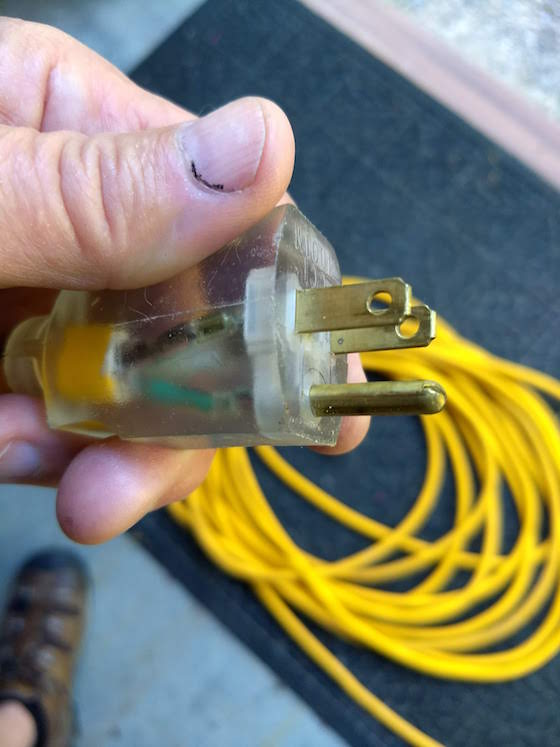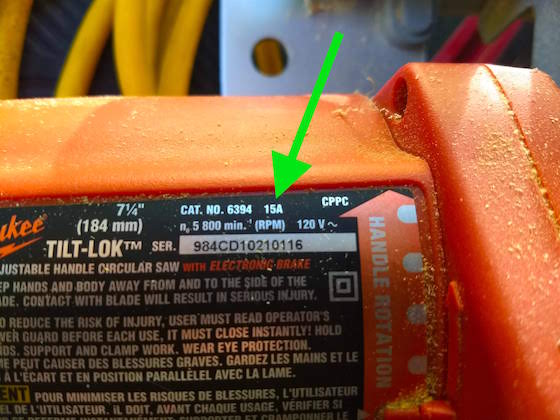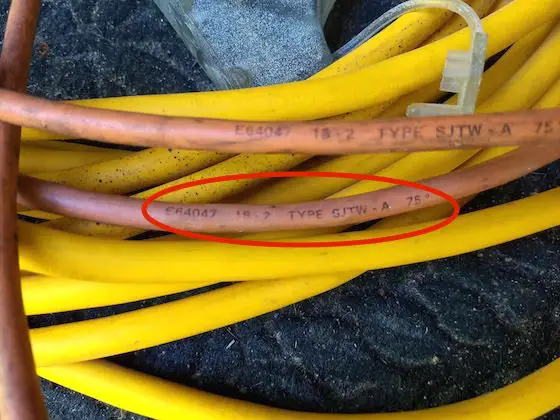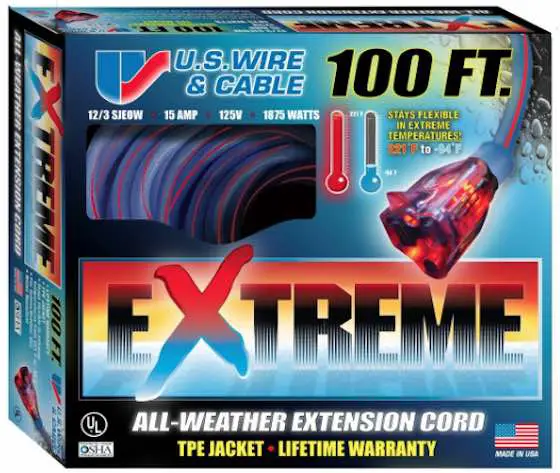Extension Cords Size Chart

Extension cord sizing is not a guessing game. This is a beefy 12-gauge extension cord. This is the male end in my hand and the female end has a small glowing light in it when energized. Copyright 2018 Tim Carter
"Electricity encounters friction as it travels through electrical wires. Knowing this, use only as much extension cord as you really need. I can call you on the phone to answer your extension cord questions so you don't get KILLED or BURN DOWN YOUR HOME. The call is FREE if you're not satisfied with my answers. CLICK HERE to set up the call."
Extension Cord Sizing Checklist
- Determine the amperage of the tool/appliance
- Calculate cord length - use the shortest possible cord.
- Wire gauge determines amperage load
- Watts = Amps X Volts Example: 2,400 watts = 20 amps X 120 volts
- CLICK HERE to subscribe to FREE AsktheBuilder.com Newsletter
The size of your extension cord is very important. If you under-size one, you can start a fire or ruin an expensive tool.

CLICK on my face to ensure you get the CORRECT extension cord so you or your family doesn't DIE IN A FIRE.
Fortunately, many common small hand-held electrical tools can operate without danger of motor damage when powered by a 16 gauge cord that is 100 feet long. To make sure you're properly protected, use the following sizing guidelines below.
How Do You Start to Size an Extension Cord?
You start to size an extension cord by obtaining the motor amperage from the plate on the tool. You'll find this information on the small metal plate where the serial number and model number is listed.

The green arrow points to the amperage of this professional circular saw. It shows 15A. That means 15 amps. Copyright 2018 Tim Carter
Usually, you will see an amperage rating. A tool may say it's rated for 8 amps. That's amperage.
What is Ohms Law?
Ohm's law is a physics principle that helps keep you safe with electricity. In its simplest form Ohm's law is:
Volts X Amps = Watts
This simple formula helps you to understand the sizing of extension cords because you may be required to convert an amp rating on a tool or appliance to watts.
Think about a light bulb. They're often sized by watts. The voltage in most circuits in USA homes is 120 volts. You may have a circuit breaker panel in your garage that has 15 or 20-amp breakers. All of these things concern Ohm's Law.
If for some odd reason, you see watts listed instead of amps, you can convert watts to amps easily!
Here is how you do that: The formula for the conversion is:
Voltage x Amps = Watts
120 x 20 = 2,400
120 x 15 = 1,800
Because we use 120 volts as an electrical standard here in the USA, that means that every 600 watts equal 5 amps (120 x 5 = 600).
What is Voltage Drop?
Voltage drop is the loss of voltage as it travels down a long wire.
Voltage drop is real. Electricity encounters resistance as it travels through electrical wires. Knowing this, use only as much extension cord as you really need. Resistance in the real world often creates friction which in turn almost always creates heat.
You can do your own simple experiment to demonstrate somewhat how this works. Use your one hand to rub your forearm back and forth. Go slowly at first and you may not feel much. Increase the speed of going back and forth and press down harder as you rub. That increased resistance will make your skin feel HOT for sure!
In other words, don't use a 100-foot cord for a project that is only 20 feet away. Purchase and maintain an assortment of different length cords.
Can I Have Multiple Tools On 1 Cord?
Yes, you can have multiple tools operating on one extension cord. You just have to be sure the cord is large enough to handle the loads.
I was guilty of this infraction many years ago before I fully understood all that was involved.
On construction sites, we'd commonly feed multiple saws and drills from one cord. If the circuit breaker at the panel is working fine, then you'll pop the breaker if there's a current overload.
But, if you've got a smaller-gauge extension cord, it's possible to overheat the cord and melt the insulation before the circuit breaker would trip!
However, if the breaker is bad you can either burn up the cord or damage tools from voltage drops. Use common sense.
How Do You Size an Extension Cord?
You size an extension cord by first determining the appliance or tool that will be plugged into the cord.
Determine the amperage of the tool(s) being used. Here is a handy list of some common electric power tools. The average amperage is listed below the tool. Always check on your tool label for its specific amperage.
Here are some COMMON amperage ratings of tools around your home:
- Circular saw: 12-15 amps
- Power drill: 3-7 amps
- Hedge Trimmer: 2-3 amps
- Weed Wacker: 2-4 amps
- Electric Chain Saw: 7-12 amps
- Leaf Blower: 6-12 amps
- Electric Lawn Mower: 6-12 amps
- Table Saw: 14-20 amps!
- Reciprocating Saw: 6-8 amps
- Router: 4-6 amps
Is the Length of the Cord Important?
Yes, the longer the cord is the greater the voltage drop will be. If you must go a distance greater than 100 feet, then upsize the extension cord.
Calculate the length of the cord you will need. Of course, you want to determine the maximum distance you think you will be from a permanent electrical outlet.
What Does Wire Gauge Mean?
Wire gauge is the measure of the diameter of the metal conductors in the extension cord. Common extension cord wire gauges are:
- 18
- 16
- 14
- 12
- 10
Use the following list to select the proper gauge extension cord. Remember, wire gauge refers to the thickness of the actual copper wire. As a wire gets thicker it can carry more electricity (amps). To confuse us, some idiot decided that as a wire gets thicker (bigger) the gauge number should get smaller!

The orange cord is only 18 gauge. Look how thin it is compared to the yellow cord that's 12-gauge. NOTE the 18-2 before the word TYPE in the red oval. That's how you know it's 18-gauge wire. Copyright 2018 Tim Carter
Here's what I mean. A 14-gauge wire can handle LESS current than a 12-gauge wire. The number 14 is bigger than 12. Confused? You should be!
What Load Can Each Gauge Wire Handle?
16-Gauge Cords: Any 16-gauge cord between 0 and 100 feet long will adequately handle tool loads up to 10 amps.
14-Gauge Cords: Any 14-gauge cord between 0 and 50 feet long will adequately handle loads between 10 and 15 amps.
12-Gauge Cords: If your tool load is between 10 and 15 amps and the length of the cord is 50 to 100 feet, you need a 12-gauge cord to safely power any tool.

This is a great extension cord for many purposes. CLICK THE IMAGE NOW to have it delivered to your home.
Why Does my Circuit Breaker Trip With the Right Cord?
Your circuit breaker may trip because the tool you're trying to power draws too much current. This is very common if you're trying to operate a large table saw cutting thick wood.
CAUTION: Most circuits in ordinary houses are wired with 14-gauge solid copper wire. This means you'll see a 15-amp breaker on the circuit breaker panel.
You may purchase a 12-gauge extension cord thinking that you'll be able to operate a powerful table saw but the breaker will probably trip when you load the saw. Remember, the circuit is rated for the SMALLEST SIZED cable or wire in the circuit.
Do Other Things on a Circuit Add to the Load?
Yes, other things, like a garage light or some other appliance, could be on the same circuit you've plugged the extension cord into. This adds to the total load on the circuit! You may think you have 15 amps available going to your extension cord, but several of those amps might be in use from something else.
B174


106 Responses to Extension Cords Size Chart